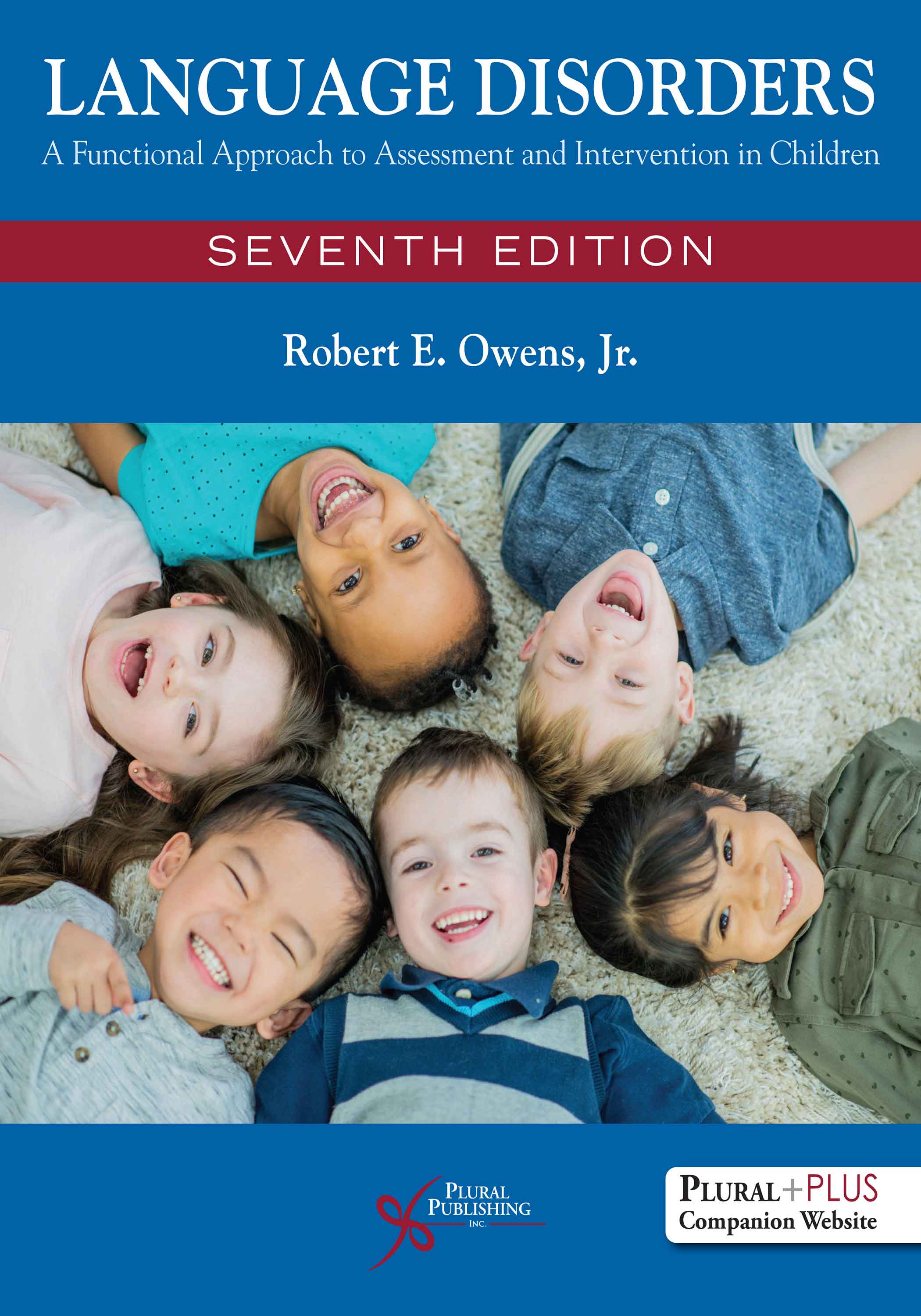
Language Disorders: A Functional Approach to Assessment and Intervention in Children
Seventh Edition
Robert E. Owens, Jr.
Details: 759 pages, 2-Color, Softcover, 8.5" x 11"
ISBN13: 978-1-63550-413-2
© 2024 | Available
For Instructors
Purchase
Thoroughly updated to meet the needs of today’s students in communication sciences and disorders programs, Language Disorders: A Functional Approach to Assessment and Intervention in Children, Seventh Edition is a comprehensive overview of language disorders and clinical practice with a focus on the child’s overall communication effectiveness. Unlike other texts that have a disorder-specific focus, this book emphasizes a functional and holistic approach to assessment and intervention by shifting the perspective to how a child uses the language feature targeted and how assessment can consider language as it’s used. The author presents intervention methods in a system of least prompts, followed by information on each area of language and literacy. Generalization is foremost throughout the text.
Known for writing numerous bestselling textbooks related to speech-language pathology, the author approaches this complex subject in a practical matter while maintaining a conversational writing style that resonates with students.
Key Features
- Each chapter begins with a case example
- Information on children from culturally and linguistically diverse backgrounds is woven into each chapter
- “Food for Thought” boxes invite students to move beyond the text and consider the implications for assessment and intervention of the material
- Key terms are highlighted throughout and included in a handy glossary
- Numerous tables provide easy reference on the many techniques and norms
- Multiple appendices include additional practical information
New to the Seventh Edition
- New and improved modern layout with color enhancements
- 600+ new references highlighting the latest theoretical and evidence-based practices
- Greater focus on discussions of assessment of children with culturally and linguistically diverse backgrounds
- New section on developmental language disorders (DLD), with new and more inclusive terms
- Increased emphasis on autism spectrum disorder (ASD)
- The chapters on language and narrative analysis have been strengthened and consolidated into one
- Increased number of figures and tables
Instructor test bank available on the Respondus Test Bank Network.
Review
“…The book is written for students and practitioners in speech-language pathology. It is an excellent resource for master's level SLP students. Because of the author's instructional and practical writing style and how he approaches issues in an almost conversational manner, it also is appropriate for undergraduate students. New and seasoned SLPs can benefit from the content, examples, focus on generalization, and current evidence-based discussions and practical suggestions in the book. In particular, school-based SLPs will benefit from the discussions on classroom intervention and assessment and remediation of children from culturally and linguistically diverse backgrounds. The author is not only a respected expert in the field of speech-language pathology who has written numerous texts, but is also a skilled instructor, which is evident by his writing style.
This book thoroughly describes language assessment and intervention in numerous contexts. This is accomplished within 13 chapters, each of which begins with a case study. The first three chapters focus on the author's approach and overview of language disorders in specific populations. Five chapters address assessment from preschool and school-age children, including instruction and description of language sample analysis. Five chapters discuss intervention and take a functional approach describing what to address in intervention and how to teach it. The final two chapters address literacy and classroom intervention. Eight appendices provide helpful additions, such as a list of formalized language measures, language sampling materials, and intervention techniques and activities. The book is readable and almost conversational as the author describes each assessment technique intervention, incorporating numerous examples. The book focuses on early intervention through school-aged children, with adolescent language and intervention specifically addressed minimally relative to the rest of the book. There are 70 pages of references and a helpful glossary and index at the end of the book.
The seventh edition offers a comprehensive update to the sixth edition and is a thorough and exceptionally written work. The book is an excellent resource for professors and a comprehensible and practical text for graduate and undergraduate students. It also is helpful for those engaged in school-based clinical practice. The book is unique in its thorough didactic approach to the subject…”
–Suzanne M Welty, MA, EdD, CCC, Biola University, from Doody’s Reviews (March 2023)
PluralPlus Online Ancillaries
For instructors: PowerPoint Slides, Test Bank, Syllabus
For students: Quizzes, eFlashcards
Preface
Acknowledgements
Chapter 1. A Functional Language Approach
Language and Language Disorders
Traditional and Functional Models
Traditional Intervention Approaches
The Functional Approach
Role of Pragmatics in Intervention
Dimensions of Communication Context
Summary
Role of Generalization in Intervention
Variables That Affect Generalization
Evidence-Based Practice
Getting “It”
Conclusion
Chapter 2. Language Disorders
Developmental and Educational Outcomes
Possible Risk and Related Factors
Neurological Basis
Aspects of Language Affected
Information Processing
Attention
Discrimination
Organization
Memory
Processes
Summary
Diagnostic Categories
Continuum of Function
Broad Groupings
Developmental Language Disorders
Social Communication Disorder
Conclusion
Chapter 3. Language Disorders Associated With Other Disorders
Language Disorders Associated With Autism Spectrum Disorder
Development
Characteristics
Risk Factors
Language Characteristics
Possible Causal Factors
Summary
Language Disorders Associated With Learning Disability/Specific Learning Disorder
Description
Language Characteristics
Possible Causal Factors
Dyslexia/Specific Learning Disorder With Impairment in Reading and Writing
Similar Disorders: Attention-Deficit/Hyperactive Disorder
Seemingly Similar Disorders: Prenatal Drug and Alcohol Exposure
Summary
Language Disorders Associated With Intellectual Developmental Disorder
Language Characteristics
Possible Causal Factors
Language Disorders Associated With Neurocognitive Disorders
Traumatic Brain Injury
Cerebrovascular Accident
Summary
Language Disorders Associated With Maltreatment: Neglect and Abuse
Language Characteristics
Possible Casual Factors
Summary
Language Disorders Associated With Less Frequent Disorders
Late Language Emergence
Childhood Schizophrenia
Selective Mutism
Otitis Media
Deafness
Implications
Conclusion
Chapter 4. Early Communication Intervention
Legal Basis for Early Intervention
The Early Intervention Model
Children Served in ECI Programs
Established Risk
At-Risk Children
ECI Assessment
Transdisciplinary Model of Assessment
Family Concerns, Priorities, and Resources
Informal Communication Assessment
Formal Assessment
Organizing an Early Language and Communication Assessment
Considerations for Infants With Culturally/Linguistically Diverse Backgrounds
ECI Intervention
Use of Daily Routines
TeleHealth
Recordkeeping
Intervention Strategies
Nature Settings and Partners
Culturally Responsive Intervention
A Hybrid Model
Intervention for Children With Autism Spectrum Disorder
Augmentative and Alternate Communication
Types of AAC
Evidence-Based Practice
Assessment
AAC Intervention
Summary
Conclusion
Chapter 5. Assessment of Preschool and School-Age Children With Language Disorders
Psychometric Versus Descriptive Procedures
Normalist Assessment Measures
Descriptive Assessment Approaches
An Integrated Functional Assessment Strategy
Referral, Screening, Questionnaire, and Interview
Observation
Formal Language Testing
Assessment of Related Cognitive Factors
Dynamic Assessment
Sampling
Conclusion
Chapter 6. Language Sampling
Extent of Language Sampling Use
Planning a Language Sample
Representativeness
Language Sampling Contexts
Collecting a Language Sample
Conversational Samples
Narrative Samples
Recording the Sample
Collecting Samples of Written Language
Transcribing the Oral Sample
Utterances
Conclusion
Chapter 7. Language Sample Analysis (LSA)
Levels of Language Sample Analysis
Communication Event
Across Utterances and Partners
Within Utterances
Narrative Analysis
Macrostructure Analysis
Microstructure Analysis
Reliability and Validity
Summary
Computer-Assisted Language Sample Analysis (CLSA)
Conclusion
Chapter 8. Assessment of Children From Culturally and Linguistically Diverse Backgrounds
Difference or Disorder?
State of Service Delivery
Lack of Academic Preparation
Unfamiliarity With Different Languages and Cultures
Lack of Appropriate Assessment Tools
Summary
Language Assessment of a Child Who Is an ELL
Who Are ELLs?
Importance of Accurate Assessment
Overcoming Bias in Assessment of ELLs
An Integrated Model for Assessment for ELLs
Components
Language Assessment of Children Speaking NMAE
Careful Use of Standardized Tests
Alternative Assessment Approaches
Model of Language Assessment of a Child Who Speaks NMAE
Components
Conclusion
Chapter 9. A Functional Intervention Model
Guidelines
Be a Reinforcer
Closely Approximate Natural Learning
Follow Developmental Guidelines
Follow the Child’s Lead
Actively Involve the Child
Remember the Influence of Context on Language
Use the Scripts Found in Familiar Events
Design a Generalization Plan First
Generalization Variables
Teaching Targets
Teaching Items
Method of Teaching
Language Teachers
Teaching Cues
Contingencies
Location
Conclusion
Chapter 10. Manipulating Context
Nonlinguistic Contexts
Linguistic Contexts
Exposure to Grammatical Targets
Explicit Instruction
Conversational Milieu
Conversations: Top-Down Teaching
Conclusion
Chapter 11. Specific Intervention Techniques
Cognitive Considerations
Information Processing
Pragmatics
Social Skills and Autism Spectrum Disorder
Intentions
Conversational Abilities
Narration
Semantics
Vocabulary and Word Meaning
Semantic Categories and Relational Webs
Word Retrieval and Categorization
Comprehension
Figurative Language
Verbal Working Memory
Syntax and Morphology
Morphology
Word Order and Sentence Types
Children With CLD Backgrounds
Use of Microcomputers
Conclusion
Chapter 12. Classroom Functional Intervention
Background and Rationale: Recent Educational Changes
Common Core State Standards
Response to Intervention
Inclusion
Collaborative Teaching
Summary
Role of the Speech-Language Pathologist
Relating to Others
Language Intervention and Language Arts
Elements of a Classroom Model
Identification of Children at Risk
Curriculum-Based Intervention
CBLI Model
Classroom Demands
Instructional Approaches
Linguistic Awareness Intervention Within the Classroom
Preschool
School-Age and Adolescent
Summary
Language Facilitation
Classroom Language Requirements
Talking With Children
Classroom Support for Children With Working Memory Deficits
Instituting a Classroom Model
Conclusion
Chapter 13. Literacy Impairments: Language in a Visual Mode
Reading
Reading Comprehension and Inferencing
Reading Problems
Children With Culturally Linguistically Diverse Backgrounds
Reading and Language Disorders
Contribution of Linguistic Awareness
Deficits in Comprehension
Deficits in Inferencing
Dyslexia
Assessment of Reading
Data Collection
Data Analysis
Assessment of Phonological Awareness
Assessment of Morphological Awareness
Assessment of Comprehension
Early Assessment of Dyslexia
Reading Assessment for Children With ASD
Language-Based Reading Intervention
Early Literacy Intervention
Preschool Emerging Literacy
School-Age Intervention
Writing
Writing Problems
Assessment of Writing
Data Collection
Data Analysis
Spelling Assessment
Language-Based Writing Intervention
Extended Writing
Spelling
Sentence Construction and Composition
Conclusion
Afterword
Appendices
A: Formal Language Measures
B: SUGAR (Sampling Utterances and Grammatical Analysis Revised)
Procedures
C: Comparison of Computer-Based Language Sample Analysis Methods
D: Selected English Morphological Prefixes and Suffixes
E: Non-Majority American English Dialects and English Influenced by
Other Languages
F: Indirect Elicitation Techniques
G: Intervention Activities and Language Targets
H: Use of Children’s Literature in Preschool Classrooms
Glossary
References
Index
Language Disorders: A Functional Approach to Assessment and Intervention in Children, Seventh Edition comes with access to supplementary student and instructor resources on a PluralPlus companion website.
The companion website is located at: https://www.pluralpublishing.com/publication/ldfaai7e
STUDENTS:
The student resources include Practice Quizzes and eFlashcards.
To access the student resources, you must register on the companion website and log in using the access code located in the front of your textbook.
INSTRUCTORS:
The instructor resources include PowerPoint Lecture Slides, a Test Bank, and Sample Syllabus. You will also have access to all of the student resources listed above.
To access the instructor resources, you must contact Plural Publishing, Inc. to be verified as an instructor and receive your access code.
Email: instructormaterials@pluralpublishing.com
Tel: 866-758-7251 (toll free) or 858-492-1555
*Note for students: If you have purchased this textbook used or have rented it, your access code will not work if it was already redeemed by the original buyer of the book. Plural Publishing does not offer replacement access codes for used or rented textbooks.
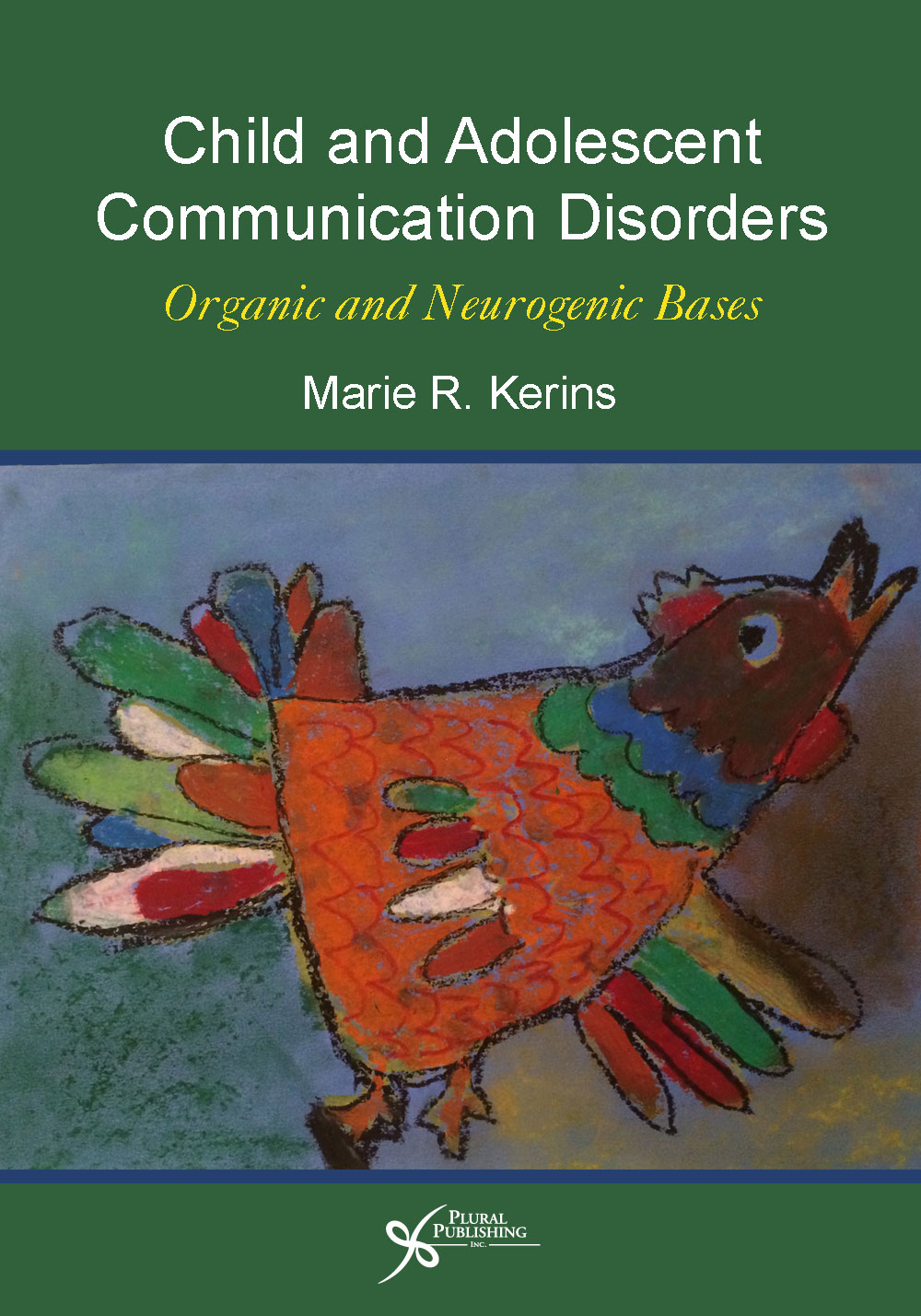
Child and Adolescent Communication Disorders: Organic and Neurogenic Bases
First Edition
Marie R. Kerins
Details: 472 pages, B&W, Softcover, 7" x 10"
ISBN13: 978-1-59756-656-8
© 2015 | Available
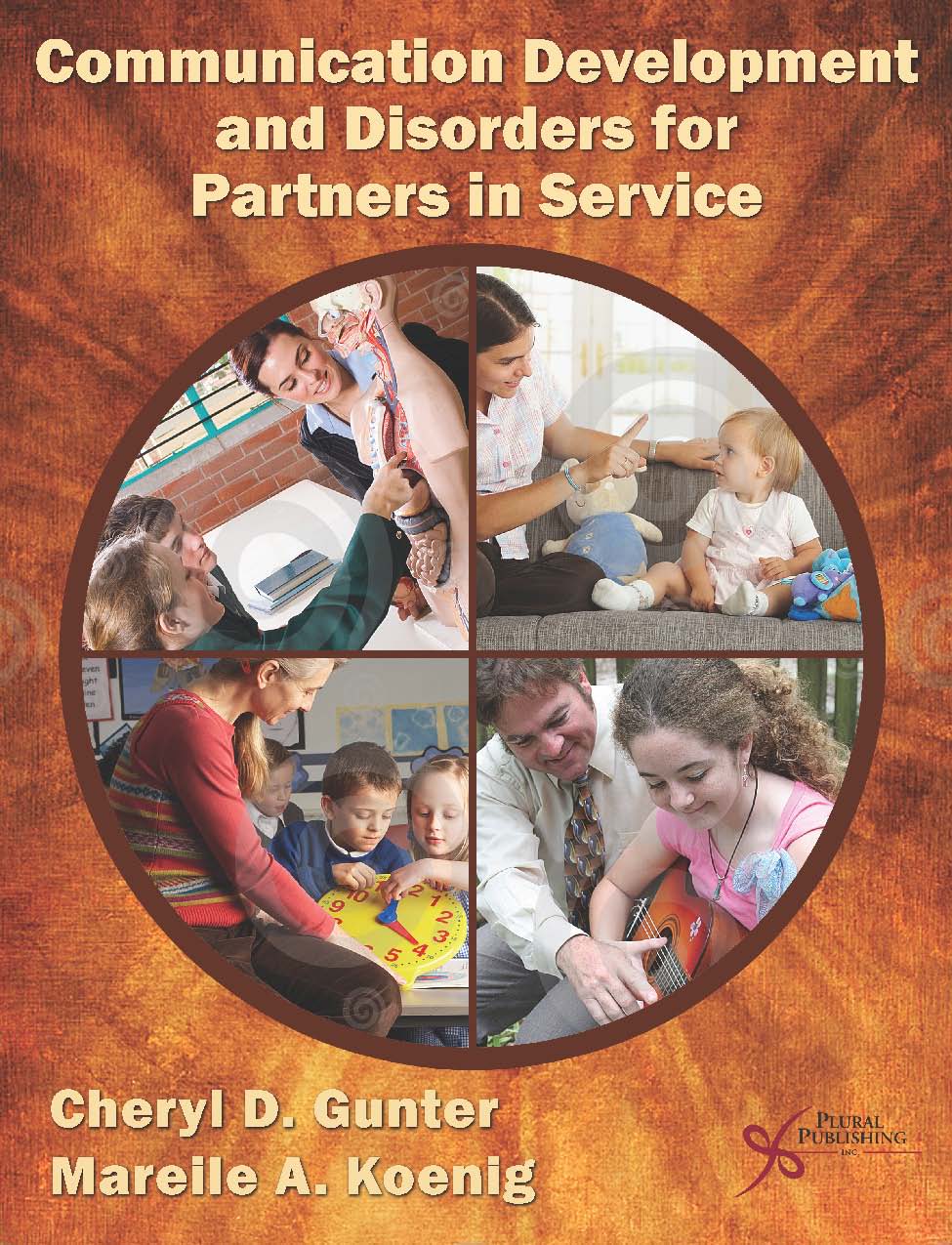
Communication Development and Disorders for Partners in Service
First Edition
Cheryl D. Gunter, Mareile A. Koenig
Details: 304 pages, B&W, Softcover, 8.5" x 11"
ISBN13: 978-1-59756-025-2
© 2011 | Available
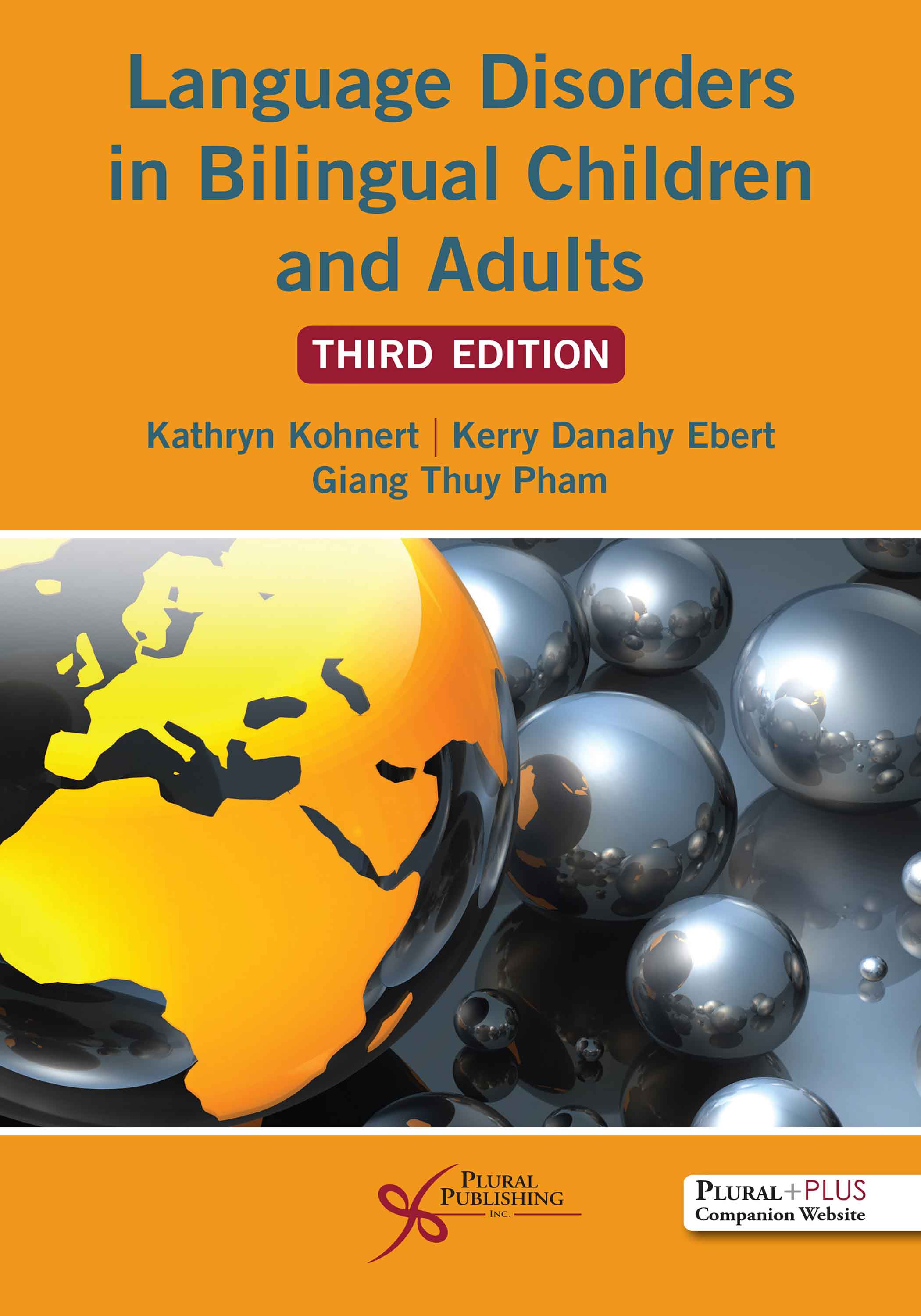
Language Disorders in Bilingual Children and Adults
Third Edition
Kathryn Kohnert, Kerry Danahy Ebert, Giang Thuy Pham
Details: 375 pages, B&W, Softcover, 6" x 9"
ISBN13: 978-1-63550-189-6
© 2022 | Available
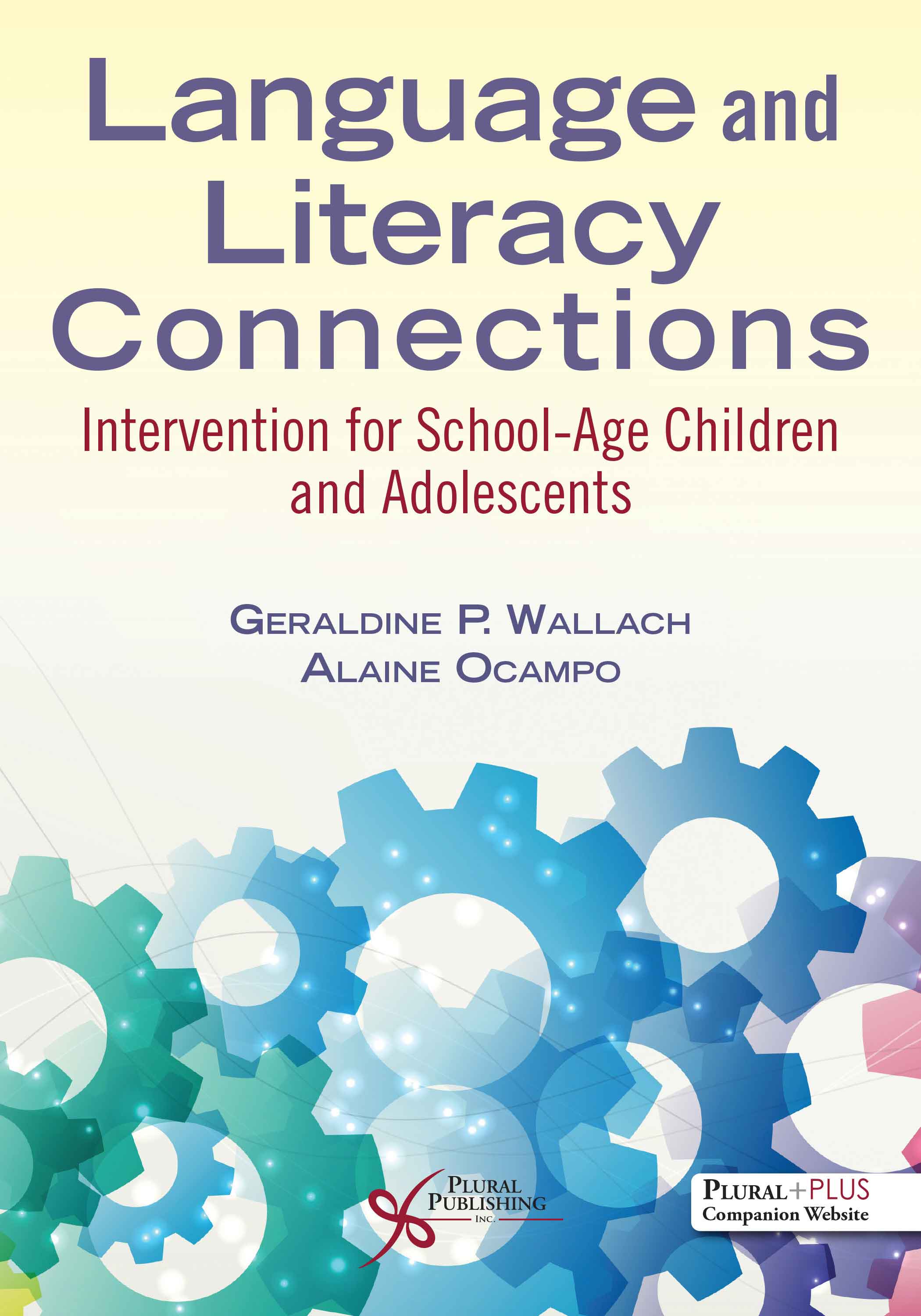
Language and Literacy Connections: Intervention for School-Age Children and Adolescents.
First Edition
Geraldine P. Wallach, Alaine Ocampo
Details: 358 pages, B&W, Softcover, 7" x 10"
ISBN13: 978-1-63550-213-8
© 2022 | Available
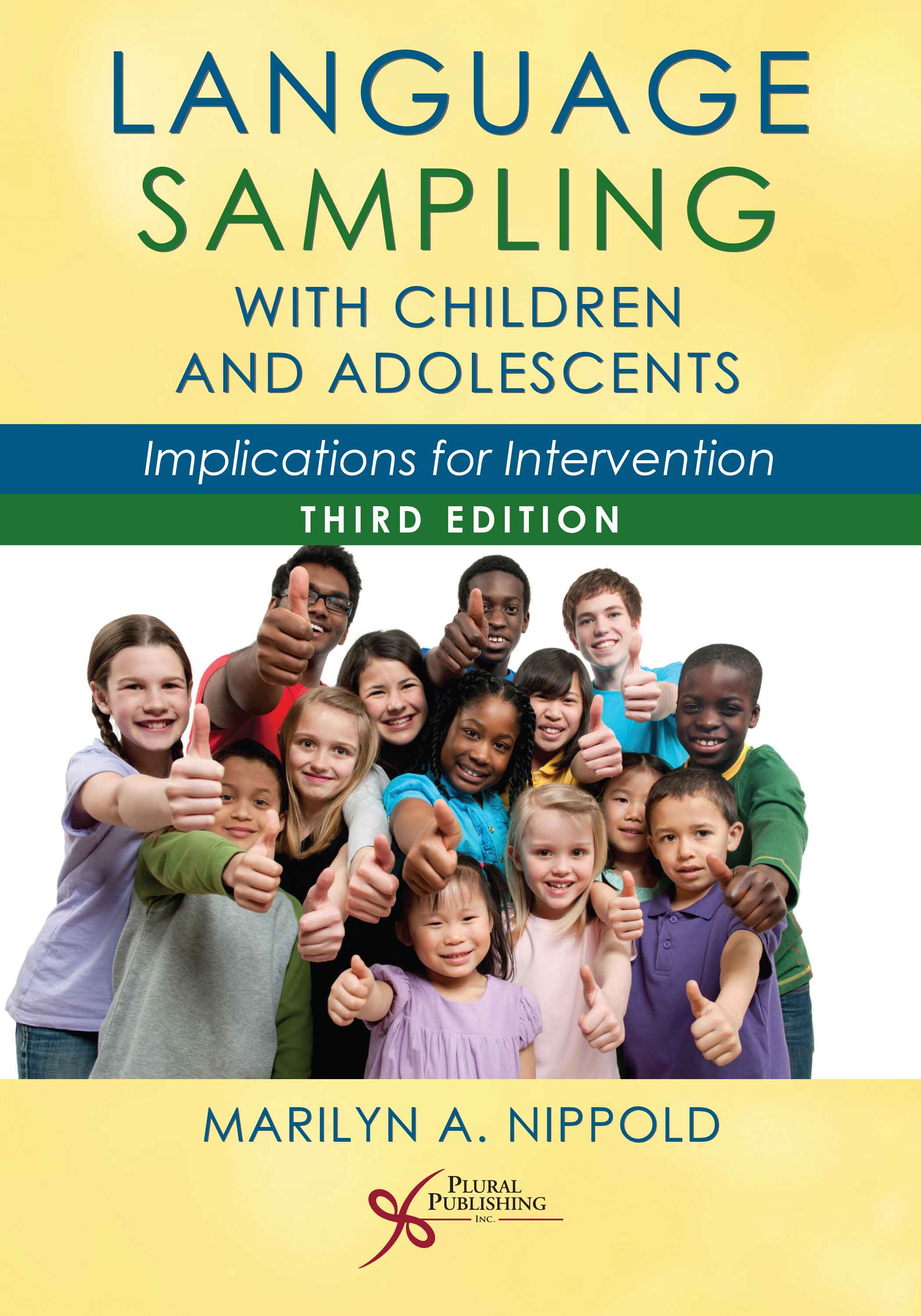
Language Sampling With Children and Adolescents: Implications for Intervention
Third Edition
Marilyn A. Nippold
Details: 437 pages, B&W, Softcover, 7" x 10"
ISBN13: 978-1-63550-276-3
© 2021 | Available
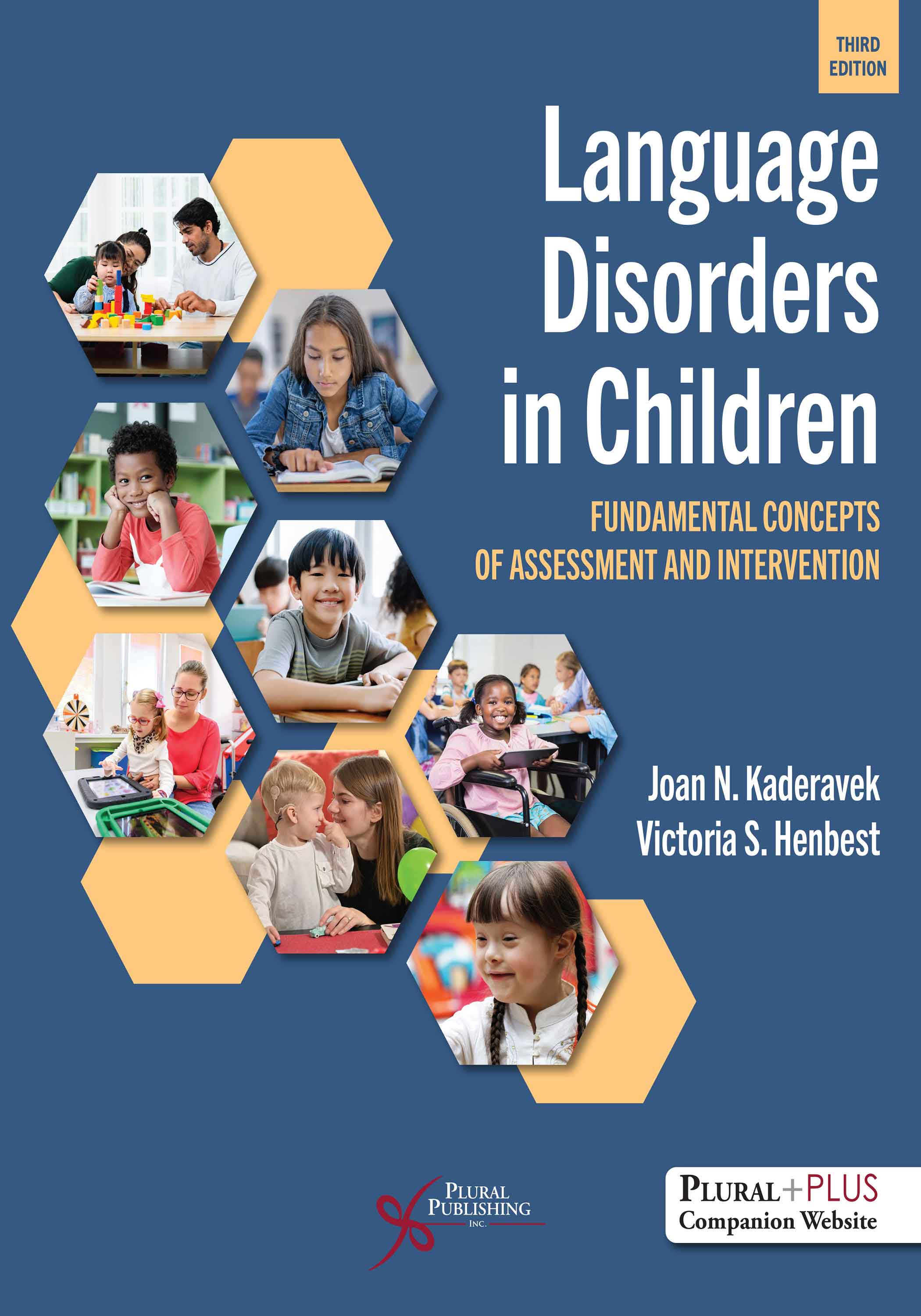
Language Disorders in Children: Fundamental Concepts of Assessment and Intervention
Third Edition
Joan N. Kaderavek, Victoria S. Henbest
Details: 454 pages, 2-Color, Softcover, 8.5" x 11"
ISBN13: 978-1-63550-758-4
© 2026 | Available
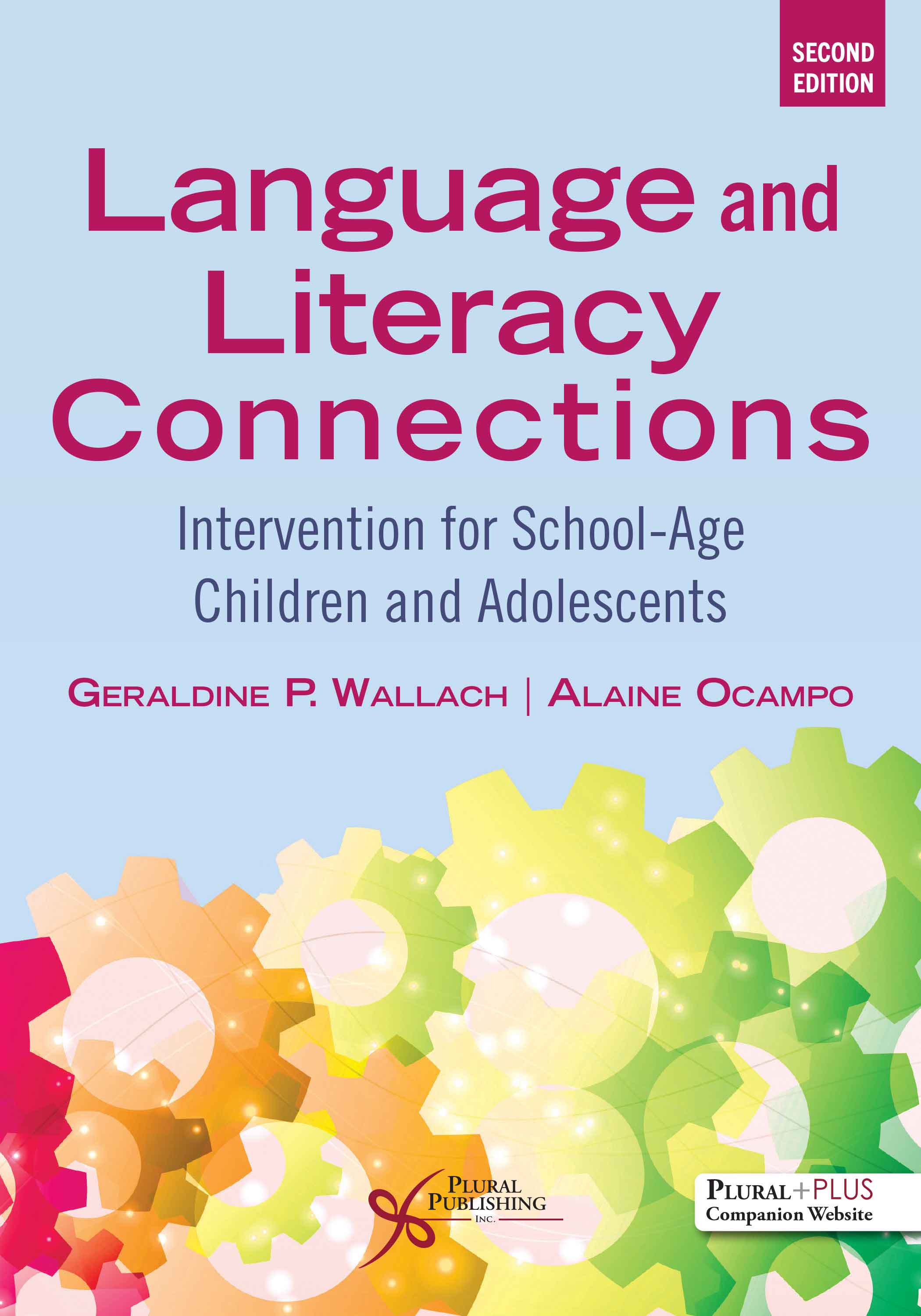
Language and Literacy Connections: Intervention for School-Age Children and Adolescents
Second Edition
Geraldine P. Wallach, Alaine Ocampo
Details: 351 pages, B&W, Softcover, 7" x 10"
ISBN13: 978-1-63550-730-0
© 2026 | Available
